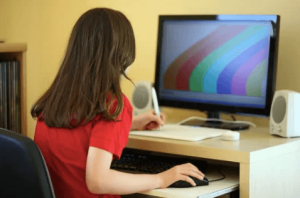The Canadian Association of Optometrists published a position statement in 2017 on the use of digital device screens by children. Here are their recommendations by age.



Screen Time Recommendations
 Take Breaks
Take Breaks
Breaks every 30 minutes, stand up and stretch, walk around and get some water.
Good Posture
Set up good workstation ergonomics: The child’s feet can lay flat on the floor or on a stool underneath the feet to allow for support. Chairs should not have arm rests unless they fit the child perfectly, as should back rests. Desks should be set at the child’s elbow height or slightly lower. There should be enough depth on the desk to allow for forearm support; this is specifically effective in preventing
musculoskeletal strain.
 Screen Placement
Screen Placement
Displays should be set in front of the child, it is recommended to place the top of the display or monitor at the child’s eye level, and then allow them to move the screen down into a comfortable viewing position as needed. The computer screen should be placed at arm’s length, and then moved as necessary.
Keyboard Placement
Keyboards should also be placed in front of the child, with the mouse close to the keyboard and appropriately sized. Workstation lighting should be equal throughout the visual field, so glare and reflections that inhibit screen viewing or cause visual discomfort are inhibited.
 No Screens Before Bedtime
No Screens Before Bedtime
Avoid screens one hour before bedtime. Screens in the bedroom are not recommended.
Increase Outdoor Activity
Outdoor activity over screen time should be encouraged. Studies show 2 hours of outdoor time can reduce the risk of myopia by over 50%.
Children may or may not complain of electronic screen-associated discomfort. Schedule regular eye exams to assess a child’s visual ability to cope with their visual demands. Your optometrist will offer treatments for deficiencies such as glasses correction, or additional treatment for other contributing eye conditions.

Dr. Alia Cappellani, Optometrist (OD, FAAO, FSLS, Dipl. ABO)
Dr. Alia Cappellani is a board-certified, residency-trained optometrist with clinical emphasis on corneal diseases, scleral contact lenses, myopia management, orthokeratology, and advanced dry eye management.

 Take Breaks
Take Breaks Screen Placement
Screen Placement No Screens Before Bedtime
No Screens Before Bedtime








